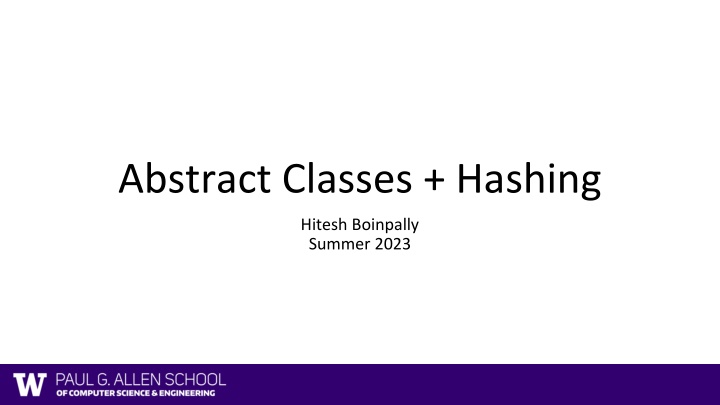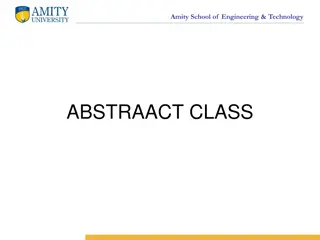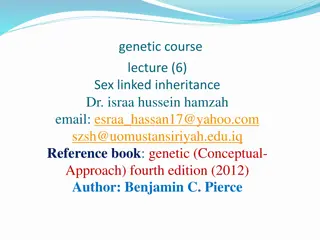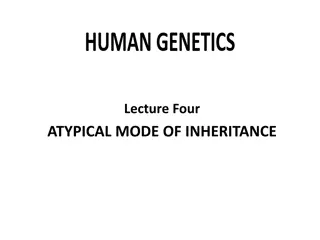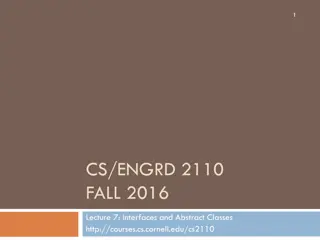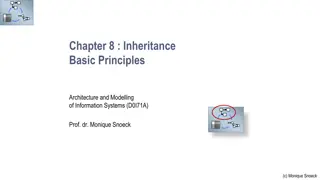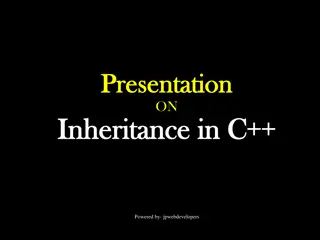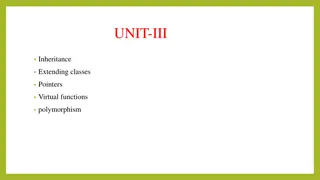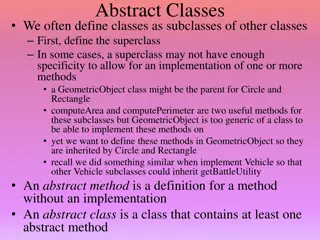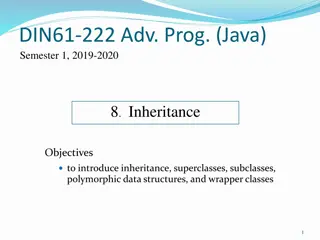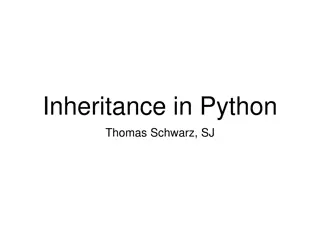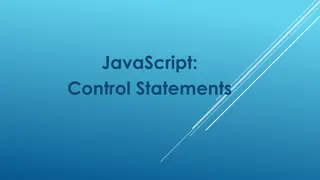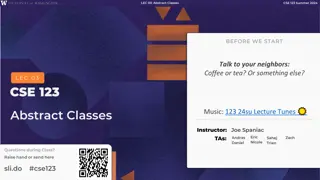Abstract Classes and Inheritance Overview - Summer 2023
This content provides an overview of abstract classes, hashing, and inheritance concepts, including forming hierarchical relationships between classes, superclass, subclass, and the is-a relationship. It also discusses the extension of classes through practical examples with MusicPlayer, TapeDeck, IPod, and IPhone. The lessons cover code sharing, code reusability, and the behavior inheritance between classes.
Download Presentation

Please find below an Image/Link to download the presentation.
The content on the website is provided AS IS for your information and personal use only. It may not be sold, licensed, or shared on other websites without obtaining consent from the author.If you encounter any issues during the download, it is possible that the publisher has removed the file from their server.
You are allowed to download the files provided on this website for personal or commercial use, subject to the condition that they are used lawfully. All files are the property of their respective owners.
The content on the website is provided AS IS for your information and personal use only. It may not be sold, licensed, or shared on other websites without obtaining consent from the author.
E N D
Presentation Transcript
Abstract Classes + Hashing Hitesh Boinpally Summer 2023
Agenda Inheritance Review Abstract Classes Hashing Lesson 14 - Summer 2023 2
Inheritance Inheritance: Forming hierarchial relationships between classes Allows for sharing / reusing of code between classes Superclass: The class being extended Subclass: The class that inherits behavior from superclass Gains copy of every method Lesson 14 - Summer 2023 4
Inheritance Inheritance: Forming hierarchial relationships between classes Allows for sharing / reusing of code between classes Superclass: The class being extended Subclass: The class that inherits behavior from superclass Gains copy of every method Inheritance forms an is-a relationship Tiger extends Cat Means that Tiger is-a Cat Cat Tiger Lesson 14 - Summer 2023 5
public class MusicPlayer { public void m1() { S.o.pln("MusicPlayer1"); } } public class TapeDeck extends MusicPlayer { public void m3() { S.o.pln("TapeDeck3"); } } public class IPod extends MusicPlayer { public void m2() { S.o.pln("IPod2"); m1(); } } public class IPhone extends IPod { public void m1() { S.o.pln("IPhone1"); super.m1(); } m1() m2() m3() public void m3() { S.o.pln("IPhone3"); } MusicPlayer } TapeDeck IPod IPhone Lesson 14 - Summer 2023 6
public class MusicPlayer { public void m1() { S.o.pln("MusicPlayer1"); } } public class TapeDeck extends MusicPlayer { public void m3() { S.o.pln("TapeDeck3"); } } public class IPod extends MusicPlayer { public void m2() { S.o.pln("IPod2"); m1(); } } public class IPhone extends IPod { public void m1() { S.o.pln("IPhone1"); super.m1(); } m1() m2() m3() public void m3() { S.o.pln("IPhone3"); } / / MP1 MusicPlayer } / MP1 TD3 TapeDeck IPod2 m1() / MP1 IPod IPhone1 MP1 IPod2 m1() IPhone3 IPhone Lesson 14 - Summer 2023 7
m1() m2() m3() MusicPlayer var1 = new TapeDeck(); MusicPlayer var2 = new IPod(); MusicPlayer var3 = new IPhone(); IPod var4 = new IPhone(); Object var5 = new IPod(); Object var6 = new MusicPlayer(); / / MP1 MusicPlayer / MP1 TD3 TapeDeck IPod2 m1() / MP1 IPod ((TapeDeck) var1).m2(); IPhone1 MP1 IPod2 m1() IPhone3 IPhone ((IPod) var3).m2(); ((IPhone) var2).m1(); ((TapeDeck) var3).m2(); Lesson 14 - Summer 2023 8
m1() m2() m3() MusicPlayer var1 = new TapeDeck(); MusicPlayer var2 = new IPod(); MusicPlayer var3 = new IPhone(); IPod var4 = new IPhone(); Object var5 = new IPod(); Object var6 = new MusicPlayer(); / / MP1 MusicPlayer / MP1 TD3 TapeDeck IPod2 m1() / MP1 IPod ((TapeDeck) var1).m2(); Compiler Error (CE) ((IPod) var3).m2(); IPod2 / IPhone1 / MusicPlayer1 ((IPhone) var2).m1(); Runtime Error (RE) ((TapeDeck) var3).m2(); Compiler Error (CE) IPhone1 MP1 IPod2 m1() IPhone3 IPhone Lesson 14 - Summer 2023 9
The Rules Lesson 14 - Summer 2023 10
Abstract Classes Allow us to construct classes that leverage both inheritance and interface ideas Abstract classes cannot be instantiated (like interfaces) Include method implementations that can be leveraged with inheritance Can define abstract methods, which must be implemented by any subclass (like interfaces) Lesson 14 - Summer 2023 12
Agenda Inheritance Review Abstract Classes Hashing Lesson 14 - Summer 2023 13
Recall: Arrays Allow for random access (continguous memory) Have fast access if we know the index we are looking for Runtime of adding a value to an unsorted array? Runtime of checking if a value exists in an unsorted array? Lesson 14 - Summer 2023 14
Hashing Idea: Map every value for some object to some integer index Store these values in an array based on the index (hash table) Hash Function: An algorithm to do this mapping Idea for integers: HF(x) = x % table.length Lesson 14 - Summer 2023 15
Hashing Idea: Map every value for some object to some integer index Store these values in an array based on the index (hash table) Hash Function: An algorithm to do this mapping Idea for integers: HF(x) = x % table.length set.add(11); set.add(49); set.add(24); set.add(7); // 11 % 10 == 1 // 49 % 10 == 9 // 24 % 10 == 4 // 7 % 10 == 7 index value 0 0 1 2 0 3 0 4 5 0 6 0 7 7 8 0 9 11 24 49 Lesson 14 - Summer 2023 16
Hashing Efficiency public static int hashFunction(int i) { return Math.abs(i) % elementData.length; } Add: set elementData[HF(i)] = i; Search: check if elementData[HF(i)] == i Remove: set elementData[HF(i)] = 0; What is the runtime of add, contains, and remove? O(1)! Are there any problems with this approach? Lesson 14 - Summer 2023 17
Good Hash Functions Goal: Map an object to a number Requirements: The same object should always have the same number If two objects are considered equal they should have the same hash code Lesson 14 - Summer 2023 18
Good Hash Functions Goal: Map an object to a number Requirements: The same object should always have the same number If two objects are considered equal they should have the same hash code To be good: Results should be distributed approximately uniformly Should look random Lesson 14 - Summer 2023 19
Good Hash Functions Goal: Map an object to a number Requirements: The same object should always have the same number If two objects are considered equal they should have the same hash code To be good: Results should be distributed approximately uniformly Should look random How to write a hash function for String objects? Lesson 14 - Summer 2023 20
Hashing Objects The hashCode function inside String objects looks like this: public int hashCode() { int hash = 0; for (int i = 0; i < this.length(); i++) { hash = 31 * hash + this.charAt(i); } return hash; } As with any general hashing function, collisions are possible. Example: "Ea" and "FB" have the same hash value. Early versions of Java examined only the first 16 characters. For some common data this led to poor hash table performance. Lesson 14 - Summer 2023 21
Hashing Objects Hashing integers is easy (just mod by length) For objects, all Java objects contain the hashCode method (inherited from Object class) public int hashCode() Returns the hash code for an object hashCode s implementation varies based on the object You can define your own for your objects! Lesson 14 - Summer 2023 22
Hash function for objects public static int hashFunction(E e) { return Math.abs(e.hashCode()) % elements.length; } Add: set elements[HF(o)] = o; Search: check if elements[HF(o)].equals(o) Remove: set elements[HF(o)] = null; Lesson 14 - Summer 2023 23
